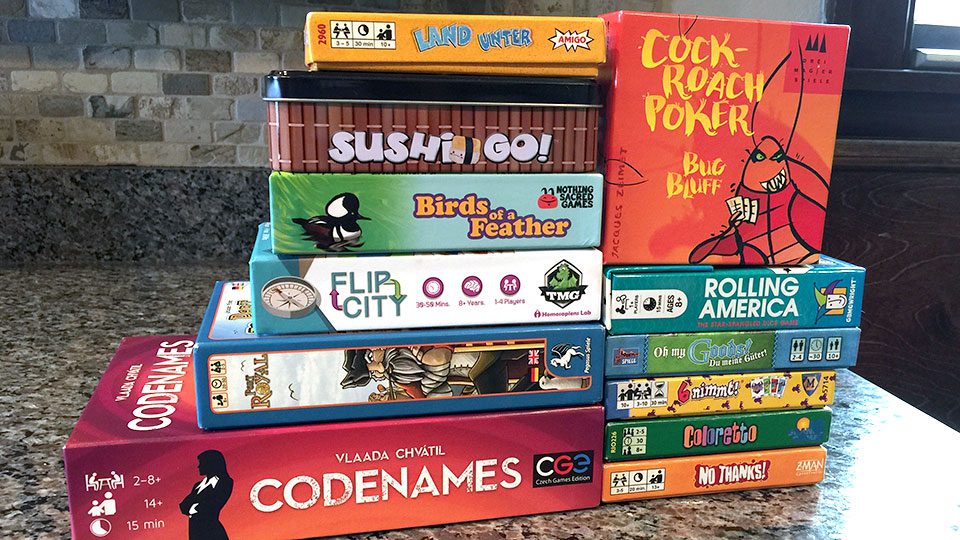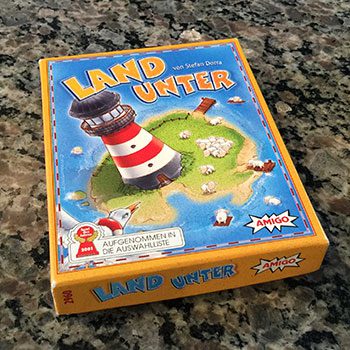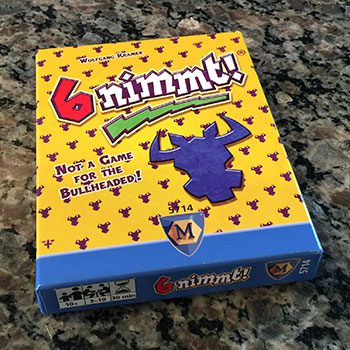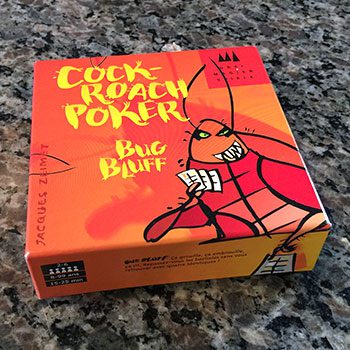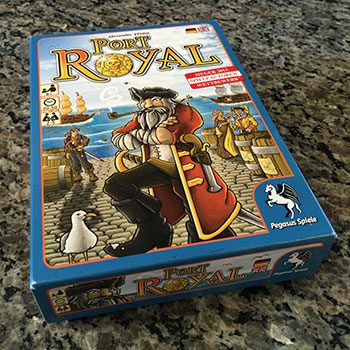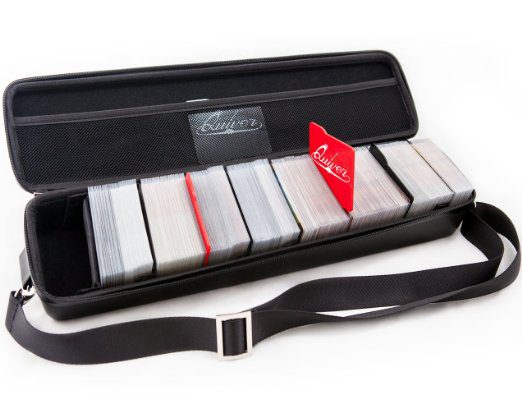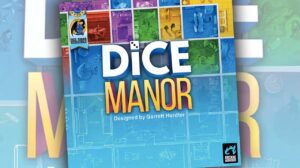Earlier this week a friend mentioned that he was going to a conference. He knew that I was big fan of small box games and so he asked me what games I’d take if I wanted to travel light, but not sacrifice quality for size. I thought about it and came up with the following list.
My criteria was simple:
- The game must be primarily card or dice based.
- Must be small enough to fit into a purse, or backpack pocket.
- Must support at least 4 players, bonus points for higher player counts.
- Must be easy to teach.
Before going any further it’s worth mentioning the current undisputed king of light cards games: Uno. I didn’t include it on this list because I think there are better alternatives to Uno. But feel free to bring it along if you like!
What this leaves you with are games that are highly portable, easy to teach and play, and support a good number of players. This isn’t a definitive list, but simply a list of games that I like playing. If I leave out your favorite, let me know in the comments. Are these games any good? Let’s find out!
1) No Thanks
No Thanks contains a single deck of 33 cards numbered 3 – 35 and a bag of chips, and comes in a small two piece box. No Thanks can play 3-5 people, takes about 20 minutes to play, and the goal of the game is to have the least number of points.
Players take turns drawing a single card from the deck, and deciding if they want to keep it. Keeping the card gives you points. Passing on the card requires the player to contribute a chip to the pot, and play continues to the player on the left who makes the same decision of keep or pass. Subsequent players keeping the card also take the chips. Play continues until the last card is drawn and the player with the least points wins.
What makes No Thanks different is that if in subsequent turns a player takes a card that is in consecutive order from one they’ve already claimed, only the lower of the two cards is counted towards their score.
No Thanks is so simple to play and teach that you could be up and playing the game in less than a minute. You can play No Thanks while you’re talking, laughing, eating, etc. and belongs in everyone’s collection.
2) Turn the Tide
Turn the Tide comes in a small two piece box and contains 108 cards in 3 distinct types: weather cards – numbered 1-60 (yellow), water level cards (blue) two sets of cards numbered 1-12, and life preserver cards (red). Turn the Tide can play 3-5 people, takes about 30 minutes and the goal if the game is to have the highest score.
Players select a card from their hand of 12 and turn them over simultaneously. The player with the highest number takes the lowest face up card from the middle of the table and lays it face up in their playing area replacing any previous card they might have had. Then the player with the second highest card takes the remaining card and lays it in front of them.
At the end of the hand the player with the highest visible card loses a Life Preserver card by flipping it over. Repeat these steps until you’ve played 12 hands. Each player records the number of remaining life preservers.
Each player then takes all the cards they played that turn and passes them to the player on their left. The game now begins again with each player using the hand of the player to their right. Play continues like this until you’ve played the same number of rounds as their are players. Then the player with the highest score wins.
Turn the Tide is a delightful little game that packs quite a lot of play into it’s tiny box. The fact that each player will get to play every one of the hands in the game is a really fun mechanic. It really takes the wind out of the sails of players who complain that they were dealy a poor hand, and makes the player who succeeds with that poor hand look like a champ.
3) 6 Nimmt
6 Nimmt (or 6 Takes in German) is served up in a two piece box and contains 104 cards numbered 1-104. In addition to the number, each 6 Nimmt card contains between 1 and 7 “bull head” icons which are used for scoring. 6 Nimmt plays from 2-10 players (simultaneously), takes up to 45 minutes for a full game, or just a few minutes or single rounds. The goal of the game is to have the fewest points.
Set up is a cinch; shuffle all the cards and lay out 4 cards face up on the table. Then deal 10 cards to each player.
Each turn, players will simultaneously pick a card from their hand, then add their card to one of the rows. The player with the lowest numbered card places their card first. A card is placed in the row which ends with the highest number that is just below the played card. Like the name of the game says, whomever places the 6th card in a row, takes the first 5 cards and sets them aside. Then the card they placed becomes the first card in the row and play continues. Once everyone has played their cards, whomever has the lowest score wins.
The first time I played 6 Nimmt I had NO clue what I was doing. But within 2 or 3 hands, each of which only lasts a few minutes, I was doing as well as the other players. It’s a clever bit of card play and requires players to pay attention to which cards have been played, and which numbers might still be unplayed.
4) Birds of a Feather
Birds of a Feather comes in a slightly larger box than the first three games, but only because the designer left room for sleeving. Birds of a Feather includes only 60 cards, but each card is full color and beautifully illustrated. Birds of a Feather plays 1-7 and takes about 15 minutes for a game. The goal of Birds of a Feather is to have the highest score.
To set up a game, shufle all the cards and deal each player a specific number of cards according to a table in the front. All the cards will be dealt out, and in games with a lower player count, you’ll be using a dummy player.
Players select cards from their hand and simultaneously play them face up to the table. Each player will mark every card which matches the “suit” card they played. Suits in this case correspond to various wildlife habitats in which birds can be found. PLayers then select another card and play that to the table, again marking every matching card, this time including cards played in the previous hand. Players continue until they each have a single card left, at which point the game is over. Points are marked for each card, along with bonus points for marking each bird within a habitat.
Birds of a Feather is the new kid on the block, releasing late last year. While it is new to the table, it’s already winning people over with it’s charming art and fun, simultaneous gameplay.
Read our review of Birds of a Feather.
5) Cockroach Poker
Cockroach Poker includes 64 cards in eight suits. Each suit being a different “critter”: scorpions, flies, spiders, bats, and of course cockroaches. Cockroach Poker plays 2-6 players and a game will take about 20 minutes. The goal of the game is to force one player to collect 4 of any one type of critter. The player loses, and every other player wins.
Setup is a breeze. Shuffle the cards and deal them out to everyone.
On their turn a player takes a card from their hand and passes it face down to the player on their left. They then declare a suit: “Scorpion”. The receiving player must choose whether to:
- Accept the card: and call either “true” or “false”, then turn the card face up. If the player is wrong they keep the card in front of them face up. If the player is right, they pass it back to the previous player who keeps it face up in front of them.
- Peek at the card: then pass it face down to the next player announcing that the card is indeed a “Scorpion”, or stating a new critter. The next player then has the same 2 choices.
The game is over when one player has 4 cards of the same suit in front of them, or when a player runs out of cards. In either case that player loses and all other players win.
Cockroach Poker, perhaps the most oddly named game on this list, has nothing to do with poker. I picked it up on a whim, having heard nothing about it previously. I’ve played it a number of times with friends and coworkers and have never laughed so hard. Do you play the straight game and always tell the truth? Or do you lie through your teeth and force the next player to trust you every time? No matter what you’ll have a fantastic time playing this game.
6) Port Royal
Port Royal is the biggest game on this list, but only in box size. Port Royal includes 120 cards which have a nice dual sided aspect. One side of the card features a single coin which lets you treat the card as money, while the other side of the card has a number of different options. Port Royal allows for 2-5 players and a game will take between 20-50 minutes. The goal of Port Royal is to be the player with the most points.
Each player is dealt a number of cards face down to be used as money. A turn is broken into a Discover phase and a Trade & Hire phase. In the Discover phase a player begins turning over cards from the main deck until either they choose to stop, or “bust” by turning over two cards of the same color in which case play moves to the player on their left. If they choose to stop then they’re able to select one of the cards from the face up cards as their own. Then in clockwise order each other player is able to purchase one of the remaining face up cards. Then all the cards in the middle are discarded and play moves to the left.
Many of the cards in Port Royal feature victory points which are the primary means by which to win the game. Plan continues until one player reaches 12 points at which time the game ends and the player with the highest score is the winner.
Port Royal is a push your luck style game, and also has a tidy little engine building mechanic. In my opinion, Port Royal starts pretty slow, then ramps up quickly about 15 minutes in. The push your luck aspect of the game can bite you until you get a feel for it. But once you do, you’ll instantly see the appeal.
You might also be interested in my interview with Alexander Pfister.
Read our review of Port Royal.
Packing Your Games
While I won’t go into too much detail here, it’s worth noting that you can always leave the box at home. All of these games except for No Thanks are only cards; and with No Thanks you could just as easily use peanuts, or candy, or whatever you have on hand. Throw a rubber band around these cards, stuff them into a ziploc, or what have you. Or you could also go upscale and pack them into something like The Quiver case.
However you do it, just take some games along. You never know when you’ll want to play, and you’ll be sad if you’re not ready for it!
Honorable Mentions
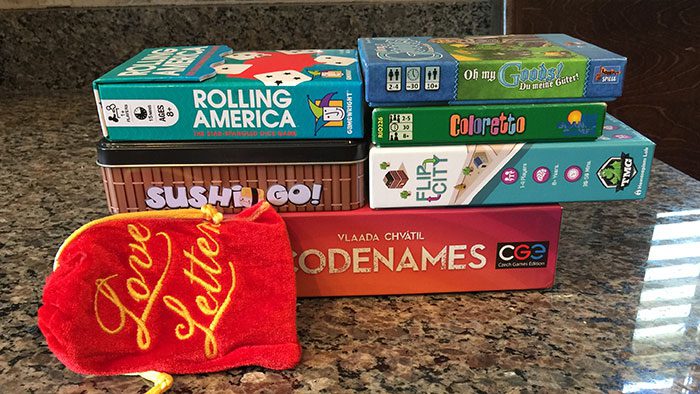
Of course in a list comprised of only 6 games you’re going to have a LOT left out. That’s okay, because this is my list…yours will probably be different. But to make sure I honor a few other really great games, here’s a few that were on my original list, but didn’t quite make the cut.
- Love Letter
- Rolling America
- Codenames
- Coloretto
- Sushi Go!
- The Game
- Oh My Goods!
- Flip City


